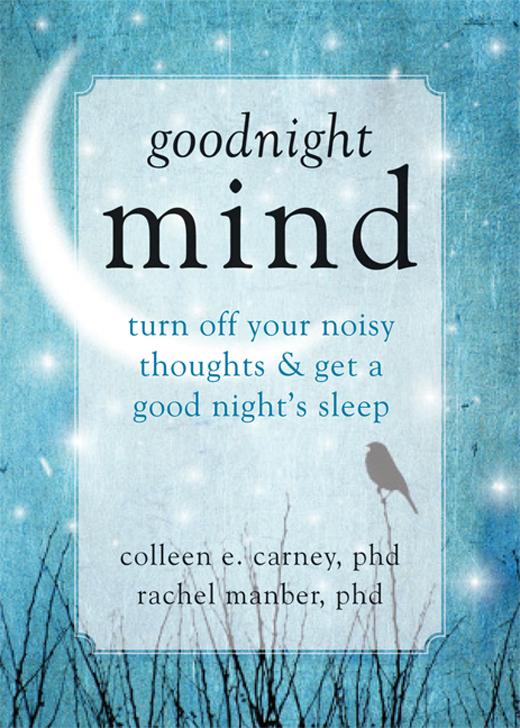
Note: The winners for this giveaway have already been chosen:
- Siri Sims
- Monterrey
As a kid, I often played movies in mind when I was trying to fall asleep.
I’d start from the opening scene, as if I’d popped a tape into my VCR (because that’s just how old I am), and I’d mentally watch as much as I could before drifting off into slumber.
As an adult, it amazes me that I was able to relax and focus my mind in this way back then, as I’ve spent much of my older life overthinking and tossing and turning in bed.
I’ve taken sleeping pills and natural alternatives. I’ve used sleep hypnosis tracks and guided meditations. I’ve bought special pillows, high-priced bedding, and fancy eye masks.
Who knew that all this effort actually worked against me—and that the solutions were much simpler than that?
In their fascinating book Goodnight Mind: Turn Off Your Noisy Thoughts and Get a Good Night’s Sleep, psychologists Colleen E. Carney and Rachel Manber offer a ten-step guide to consistent, deep, restorative sleep.
I found Goodnight Mind to be both informative and eye opening, and I’ve already reaped the benefits of better quality sleep after applying much of what I learned.
If you struggle with insomnia, ruminate under the covers, or regularly feel sleep-deprived despite spending hours in bed, you too may want to give this handy little guide a read.
I’m grateful that Colleen took the time to answer some questions about herself and her book, and that she’s provided two copies for Tiny Buddha readers.
 The Giveaway
The Giveaway
To enter to win one of two free copies:
- Leave a comment below.
- For an extra entry, tweet: Enter @tinybuddha‘s giveaway for Goodnight Mind, a book that helps you shut off your mind & get a good night’s sleep http://bit.ly/1GyyLnG
You can enter until midnight PST on Friday, May 1st.
The Interview
1. Tell us a little bit about yourself, your work, and what inspired you to write this book.
I am a psychologist specializing in sleep, particularly insomnia. I conduct research on cognitive behavior therapy for insomnia, or “CBT.”
CBT is a treatment derived from research on what causes insomnia. CBT is the frontline recommended treatment for insomnia by major agencies such as the National Institutes of Health.
My co-author and I wrote this book after writing a very popular self-help book called Quiet Your Mind and Get to Sleep. This was the first workbook that contained CBT but also provided help for those who had other issues as well, such as depressed mood, anxiety, trauma, or pain.
As successful as this book was, we learned that not everyone feels ready to complete a full self-help treatment in a book. Insomnia is such a prevalent disorder and access to CBT can be very poor, so we wanted to provide wide access to the treatment to the greatest number of people.
So we decided to write a second book based on Quiet Your Mind, with fewer, simpler steps, to reach the people that might not be ready for that—this book was Goodnight Mind.
Most people who read the book find that they become more and more confident, and more able to implement more of the steps as they go through the book.
Additionally, many of the people who read this book feel ready to take it to the next step—completing the full treatment in Quiet Your Mind and Get to Sleep.
2. In the first chapter, you recommend that we stop trying so hard to sleep better. Why do our efforts actually work against us?
Sleep is something that unfolds naturally. If you ask a good sleeper how they fall asleep, they tell you that they lay their head down and close their eyes—there is no effort to sleep, especially if you have good sleep habits.
Sleep is like falling in love—you can’t make it happen. The reason efforts to sleep can create a problem is that we have a biological system that regulates sleep and wakefulness.
If you take matters into your own hands, you undermine the system, and it sends the opposite message to the system.
For example, when people are sleeping poorly and feeling tired, they often cut back on their activities, lie down to attempt to nap, go to bed early, and/or lay in bed later in the morning.
This makes sense because they feel tired and they may be trying to cast a wide net to catch some more sleep. However, decreasing activity and spending more time in bed in a twenty-four-hour period sends a message to the system that less sleep is needed, and less deep sleep is needed.
3. Growing up, many of us learned that we need eight hours of sleep per night to function optimally. Until I read your book, I’d never considered quality might be more important than quantity. Can you expand on why this is?
We need to have adequate amounts of deep sleep in our sleep to feel physically rested. During this stage of sleep, growth hormone is secreted, a hormone associated with tissue restoration in our bodies.
People with chronic pain, such as those with fibromyalgia, often have normal quantities of sleep; however, they have less deep sleep throughout the night. They complain of poor quality sleep and such patients also complain of greater pain.
If we take someone without a pain disorder and we selectively deprive them of deep sleep, they develop aches called myalgias—so sleep is important for feeling physically restored.
Poor restorative sleep can cause or negatively affect pain. Six hours of quality sleep is far more important than eight hours of poor quality sleep.
Your readers will experience this as true. They need only remember times when they slept for long periods and felt groggy and other time in which they had little sleep and felt great.
4. I was also fascinated to learn about the sleep driver system, particularly because I’ve gotten the worst quality sleep during periods when I’ve been the least active. Can you tell us a little more about this?
When we are active our cells produce a sleepy chemical that accumulates in our brain throughout the day. When we go to bed and sleep, we eliminate this chemical and it is associated with deep sleep.
So, less activity equals less of this chemical, and less deep sleep.
When we have less deep sleep drive, we are unable to stay asleep, and we often feel unrefreshed upon awakening.
This is a problem in insomnia because most people with insomnia are less active in a twenty-four-hour period because they are exhausted and are prone to cutting back on activities, going to bed earlier, and lying in bed in the morning—these habits reduce the drive for deep sleep and conspire to maintain the insomnia.
5. As someone who’s been guilty of surfing the web under my covers, I know I’ve come to associate my bed with alertness. Aside from keeping technology out of the bedroom, what else can we do to make our bed a cue for sleep, not wakefulness?
A general rule is to avoid doing anything you do while awake, while in bed.
An essential tip for someone with insomnia is to get out of bed and leave the room if they find themselves awake.
Most people with insomnia, because they are so exhausted and desperate to sleep, stay in bed trying harder to sleep. This habit increases the association between the bed and sleeplessness.
When you cannot sleep and leave the room, you break the association with sleeplessness and the bed. While out of the room you are building sleep deprivation and more drive for deep sleep, so when you eventually return to the bedroom, you have a greater chance of sleeping.
We want your bed to be associated with sleep only. Your readers will know if this applies to them if the following scenario applies: Are you sleepy on the couch but as soon as you get into bed, it is like a switch goes off and you are wide awake?
If the answer is yes, your body now associates your bed with being awake and you will need to learn how to unpair the two.
6. In Chapter 5, you recommend creating a buffer zone between the day’s activity and sleep. What type of activities work well for this purpose, and what are a few we should avoid?
Any activity that is relaxing but won’t put you to sleep will do. A buffer zone is a transition time between the pressures of the day and relaxing into sleep, so catching up on work, housework, or homework is counterproductive.
Teens or people sensitive to light should probably avoid handheld devices this time, or it can activate their body and make it more difficult to fall asleep. Exercise is fine but for some, vigorous exercise is activating and can delay being able to fall asleep.
Most of my clients will read, watch television, enjoy their favorite hobbies, engage in mindful meditation, or go for an evening walk. People should explore what works best for them.
7. What is the most helpful thing we can do to stop worrying while lying in bed?
Get out of bed and go to another room. Worries in bed often become non-worries in another room because we become lucid. In fact, worrying in bed pairs the bed with wakefulness and worry, making it more likely that worry will become a habitual problem.
There are many other techniques covered in the book, but this is the most effective and most overlooked solution.
8. Why does counting sheep work for some people and not for others, and what’s an equally helpful alternative?
Counting sheep is a distraction technique. When people do a math problem or repeat a word repeatedly such as “the” over and over, they can fall asleep more quickly because it occupies the mind and doesn’t allow worry or sleep-interfering thoughts to occur.
The problem with these techniques is that they often don’t hold attention long enough, and our mind drifts. Counting sheep is also sleep effort—it is an attempt to make sleep happen.
When you need to count sheep, it actually means you are not ready to sleep. The most likely culprits are: 1) that you have not generated enough drive for deep sleep, and/or 2) that your bed has become associated with worry, mental activity or wakefulness. In either case, these problems are easily fixable.
9. In Chapter 8, you wrote, “Good sleepers simply do not think very much about sleep.” Can you expand on this?
By the time someone comes to me, they are often preoccupied with sleep. Having problems sleeping is so frustrating that anything sleep-related draws their attention.
Any time they feel tired, they assume it is because of sleep. As evening draws near, they start thinking about whether they will be able to sleep. When they are in bed, they worry that they won’t sleep, and the effect it will have on them the next day.
Many people with insomnia tell everyone around them about their sleeping problem, and each day their network checks in with them about how they slept the night before.
On computer tests in our lab, we can distract people with insomnia on word tasks, when we insert a sleep-related or fatigue-related word—good sleepers are not distracted with such words.
In short, whether the person is aware of it or not, insomnia produces a preoccupation with sleep and fatigue that becomes unhelpful. If we want to resist engaging in effort to sleep, we need to think about it less. We want to sleep to live, but never live to sleep.
10. How does better quality sleep improve our lives?
Sleep quality is associated with restorativeness so there are positive physical, mental, and emotional benefits to good sleep quality. You need only have a single high quality night to appreciate all it brings to your life.
You can learn more about Goodnight Mind on Amazon here.
FTC Disclosure: I receive complimentary books for reviews and interviews on tinybuddha.com, but I am not compensated for writing or obligated to write anything specific. I am an Amazon affiliate, meaning I earn a percentage of all books purchased through the links I provide on this site.
Sleeping baby image via Shutterstock
About Lori Deschene
Lori Deschene is the founder of Tiny Buddha. She started the site after struggling with depression, bulimia, c-PTSD, and toxic shame so she could recycle her former pain into something useful and inspire others to do the same. You can find her books, including Tiny Buddha’s Gratitude Journal and Tiny Buddha’s Worry Journal, here and learn more about her eCourse, Recreate Your Life Story, if you’re ready to transform your life and become the person you want to be.
- Web |
- More Posts












 Though I run this site, it is not mine. It's ours. It's not about me. It's about us. Your stories and your wisdom are just as meaningful as mine.
Though I run this site, it is not mine. It's ours. It's not about me. It's about us. Your stories and your wisdom are just as meaningful as mine. 